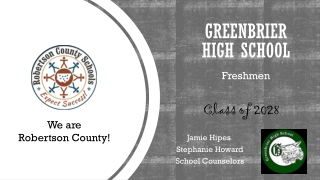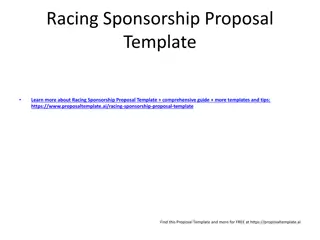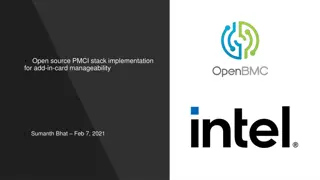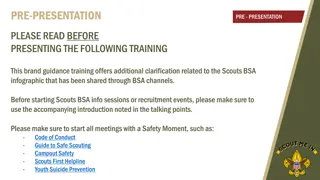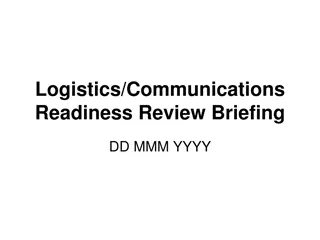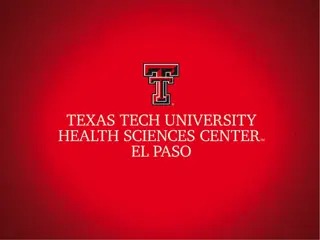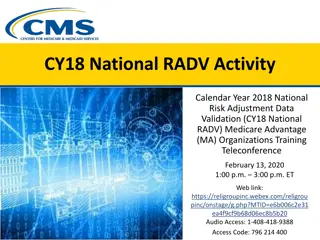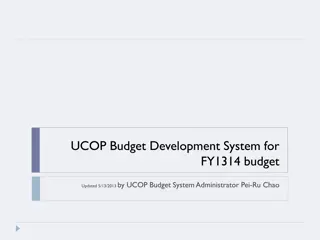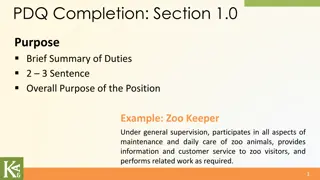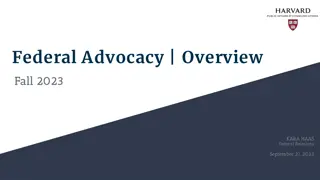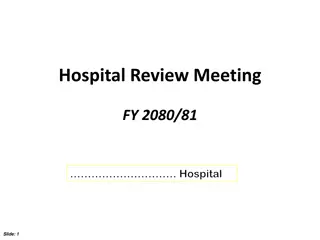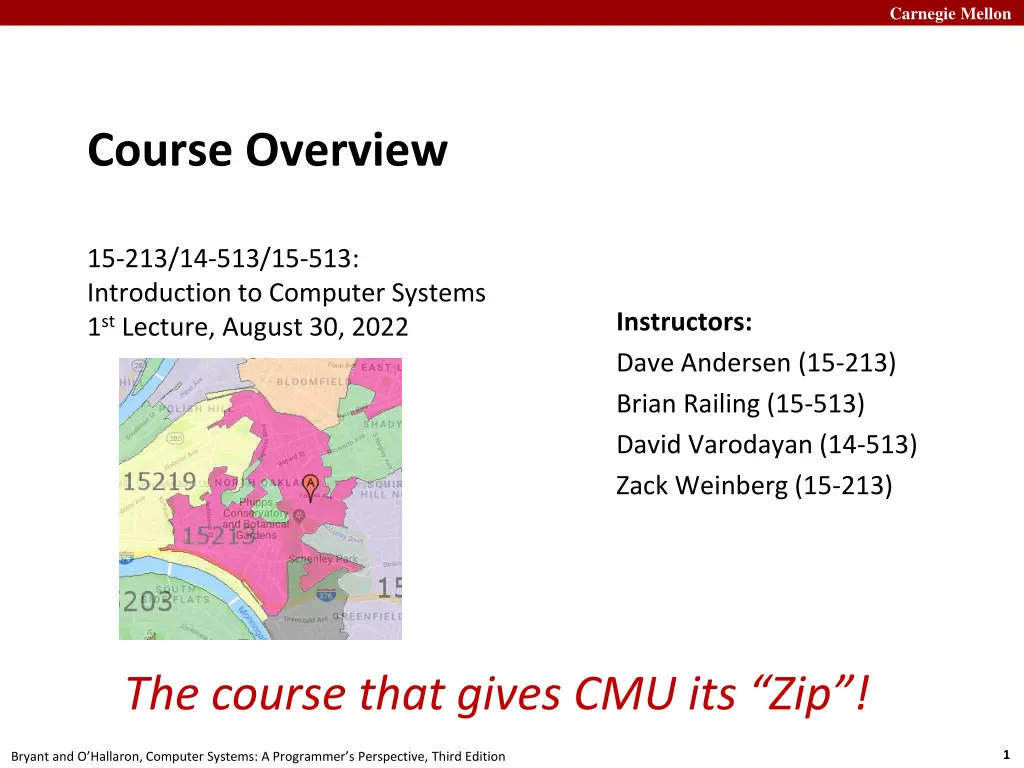
Unveiling Carnegie Mellon's Introduction to Computer Systems Course
Dive into Carnegie Mellon's renowned course on computer systems, covering key themes, instructors, and the importance of understanding how things work in the world of technology. Explore the intersection of hardware and software, enhancing your programming skills and preparing for advanced systems classes.
Download Presentation

Please find below an Image/Link to download the presentation.
The content on the website is provided AS IS for your information and personal use only. It may not be sold, licensed, or shared on other websites without obtaining consent from the author. If you encounter any issues during the download, it is possible that the publisher has removed the file from their server.
You are allowed to download the files provided on this website for personal or commercial use, subject to the condition that they are used lawfully. All files are the property of their respective owners.
The content on the website is provided AS IS for your information and personal use only. It may not be sold, licensed, or shared on other websites without obtaining consent from the author.
E N D
Presentation Transcript
Carnegie Mellon Course Overview 15-213/14-513/15-513: Introduction to Computer Systems 1st Lecture, August 30, 2022 Instructors: Dave Andersen (15-213) Brian Railing (15-513) David Varodayan (14-513) Zack Weinberg (15-213) The course that gives CMU its Zip ! 1 Bryant and O Hallaron, Computer Systems: A Programmer s Perspective, Third Edition
Carnegie Mellon Overview Introductions Big Picture Course theme Five realities How the course fits into the CS/ECE/INI curriculum Academic integrity Logistics and Policies 2 Bryant and O Hallaron, Computer Systems: A Programmer s Perspective, Third Edition
Carnegie Mellon Carnegie Mellon Instructors Zack Weinberg Dave Andersen 15-213 Brian Railing David Varodayan 15-513 14-513 3 Bryant and O Hallaron, Computer Systems: A Programmer s Perspective, Third Edition
Carnegie Mellon The Big Picture 4 Bryant and O Hallaron, Computer Systems: A Programmer s Perspective, Third Edition
Carnegie Mellon Course Theme: (Systems) Knowledge is Power! Systems Knowledge How hardware (processors, memories, disk drives, network infrastructure) plus software (operating systems, compilers, libraries, network protocols) combine to support the execution of application programs How you as a programmer can best use these resources Useful outcomes from taking 213/513 Become more effective programmers Able to find and eliminate bugs efficiently Able to understand and tune for program performance Prepare for later systems classes in CS & ECE Compilers, Operating Systems, Networks, Computer Architecture, Embedded Systems, Storage Systems, etc. 5 Bryant and O Hallaron, Computer Systems: A Programmer s Perspective, Third Edition
Carnegie Mellon It s Important to Understand How Things Work Why do I need to know this stuff? Abstraction is good, but don t forget reality Most CS and CE courses emphasize abstraction Abstract data types Asymptotic analysis These abstractions have limits Especially in the presence of bugs Need to understand details of underlying implementations Sometimes the abstract interfaces don t provide the level of control or performance you need 6 Bryant and O Hallaron, Computer Systems: A Programmer s Perspective, Third Edition
Carnegie Mellon Great Reality #1: Ints are not Integers, Floats are not Reals Example 1: Is x2 0? Float s: Yes! Int s: 40000 * 40000 --> 1600000000 50000 * 50000 --> ? Example 2: Is (x + y) + z = x + (y + z)? Unsigned & Signed Int s: Yes! Float s: (1e20 + -1e20) + 3.14 --> 3.14 1e20 + (-1e20 + 3.14) --> ?? Source: xkcd.com/571 7 Bryant and O Hallaron, Computer Systems: A Programmer s Perspective, Third Edition
Carnegie Mellon Computer Arithmetic Does not generate random values Arithmetic operations have important mathematical properties Cannot assume all usual mathematical properties Due to finiteness of representations Integer operations satisfy ring properties Commutativity, associativity, distributivity Floating point operations satisfy ordering properties Monotonicity, values of signs Observation Need to understand which abstractions apply in which contexts Important issues for compiler writers and serious application programmers 8 Bryant and O Hallaron, Computer Systems: A Programmer s Perspective, Third Edition
Carnegie Mellon Great Reality #2: You ve Got to Know Assembly Chances are, you ll never write programs in assembly Compilers are much better & more patient than you are But: Understanding assembly is key to machine-level execution model Behavior of programs in presence of bugs High-level language models break down Tuning program performance Understand optimizations done / not done by the compiler Understanding sources of program inefficiency Implementing system software Compiler has machine code as target Operating systems must manage process state Creating / fighting malware x86 assembly is the language of choice! 9 Bryant and O Hallaron, Computer Systems: A Programmer s Perspective, Third Edition
Carnegie Mellon Great Reality #3: Memory Matters Random Access Memory Is an Unphysical Abstraction Memory is not unbounded It must be allocated and managed Many applications are memory dominated Memory referencing bugs especially pernicious Effects are distant in both time and space Memory performance is not uniform Cache and virtual memory effects can greatly affect program performance Adapting program to characteristics of memory system can lead to major speed improvements 10 Bryant and O Hallaron, Computer Systems: A Programmer s Perspective, Third Edition
Carnegie Mellon Memory Referencing Bug Example typedef struct { int a[2]; double d; } struct_t; double fun(int i) { volatile struct_t s; s.d = 3.14; s.a[i] = 1073741824; /* Possibly out of bounds */ return s.d; } fun(0) --> fun(1) --> fun(2) --> fun(3) --> fun(4) --> fun(6) --> 3.14 3.14 3.1399998664856 2.00000061035156 3.14 Segmentation fault Result is system specific 11 Bryant and O Hallaron, Computer Systems: A Programmer s Perspective, Third Edition
Carnegie Mellon Memory Referencing Bug Example typedef struct { int a[2]; double d; } struct_t; fun(0) --> fun(1) --> fun(2) --> fun(3) --> fun(4) --> fun(6) --> 3.14 3.14 3.1399998664856 2.00000061035156 3.14 Segmentation fault Explanation: Critical State 6 ? 5 ? 4 Location accessed by fun(i) d7 ... d4 3 d3 ... d0 2 struct_t a[1] 1 a[0] 0 12 Bryant and O Hallaron, Computer Systems: A Programmer s Perspective, Third Edition
Carnegie Mellon Memory Referencing Errors C and C++ do not provide any memory protection Out of bounds array references Invalid pointer values Abuses of malloc/free Can lead to nasty bugs Whether or not bug has any effect depends on system and compiler Action at a distance Corrupted object logically unrelated to one being accessed Effect of bug may be first observed long after it is generated How can I deal with this? Program in Java, Ruby, Python, ML, Understand what possible interactions may occur Use or develop tools to detect referencing errors (e.g. Valgrind) 13 Bryant and O Hallaron, Computer Systems: A Programmer s Perspective, Third Edition
Carnegie Mellon Great Reality #4: There s more to performance than asymptotic complexity Constant factors matter too! And even exact op count does not predict performance Easily see 10:1 performance range depending on how code written Must optimize at multiple levels: algorithm, data representations, procedures, and loops Must understand system to optimize performance How programs compiled and executed How to measure program performance and identify bottlenecks How to improve performance without destroying code modularity and generality 14 Bryant and O Hallaron, Computer Systems: A Programmer s Perspective, Third Edition
Carnegie Mellon Memory System Performance Example void copyij(int src[2048][2048], int dst[2048][2048]) { int i,j; for (i = 0; i < 2048; i++) for (j = 0; j < 2048; j++) dst[i][j] = src[i][j]; } void copyji(int src[2048][2048], int dst[2048][2048]) { int i,j; for (j = 0; j < 2048; j++) for (i = 0; i < 2048; i++) dst[i][j] = src[i][j]; } 81.8ms 4.3ms 2.0 GHz Intel Core i7 Haswell Hierarchical memory organization Performance depends on access patterns Including how step through multi-dimensional array 15 Bryant and O Hallaron, Computer Systems: A Programmer s Perspective, Third Edition
Carnegie Mellon Why The Performance Differs copyij 16000 14000 Read throughput (MB/s) 12000 10000 8000 6000 4000 2000 copyji 0 32k s1 128k s3 512k s5 2m s7 8m Stride (x8 bytes) s9 Size (bytes) 32m s11 128m 16 Bryant and O Hallaron, Computer Systems: A Programmer s Perspective, Third Edition
Carnegie Mellon Great Reality #5: Computers do more than execute programs They need to get data in and out I/O system critical to program reliability and performance They communicate with each other over networks Many system-level issues arise in presence of network Concurrent operations by autonomous processes Coping with unreliable media Cross platform compatibility Complex performance issues 17 Bryant and O Hallaron, Computer Systems: A Programmer s Perspective, Third Edition
Carnegie Mellon Course Perspective Most Systems Courses are Builder-Centric Computer Architecture Design pipelined processor in Verilog Operating Systems Implement sample portions of operating system Compilers Write compiler for simple language Networking Implement and simulate network protocols 18 Bryant and O Hallaron, Computer Systems: A Programmer s Perspective, Third Edition
Carnegie Mellon Course Perspective (Cont.) Our Course is Programmer-Centric By knowing more about the underlying system, you can be more effective as a programmer Enable you to Write programs that are more reliable and efficient Incorporate features that require hooks into OS E.g., concurrency, signal handlers Cover material in this course that you won t see elsewhere Not just a course for dedicated hackers We bring out the hidden hacker in everyone! 19 Bryant and O Hallaron, Computer Systems: A Programmer s Perspective, Third Edition
Carnegie Mellon Role within CS/ECE Curriculum CS 122 Imperative Programming Foundation of Computer Systems Underlying principles for hardware, software, and networking 213/513 ECE Systems 18-330 Computer Security 18-349 Intro to Embedded Systems 18-441 Computer Networks 18-447 Computer Architecture 18-452 Wireless Networking 18-451 Cyberphysical Systems CS Systems 15-319 Cloud Computing 15-330 Computer Security 15-410 Operating Systems 15-411 Compiler Design 15-415 Database Applications 15-418 Parallel Computing 15-440 Distributed Systems 15-441 Computer Networks 15-445 Database Systems CS Graphics 15-462 Computer Graphics 15-463 Comp. Photography 20 Bryant and O Hallaron, Computer Systems: A Programmer s Perspective, Third Edition
Carnegie Mellon Academic Integrity Please pay close attention, especially if this is your first semester at CMU 22 Bryant and O Hallaron, Computer Systems: A Programmer s Perspective, Third Edition
Carnegie Mellon Cheating/Plagiarism: Description Unauthorized use of information Borrowing code: by copying, retyping, looking at a file Describing: verbal description of code from one person to another Even if you just describe/discuss how to put together CS:APP code snippets to solve the problem Searching the Web for solutions, discussions, tutorials, blogs, other universities 213 instances, in English or any other language Copying code from a previous course or online solution Reusing your code from a previous semester (here or elsewhere) If you take the course this semester, all work has to be done this semester (unless you have special permission from the instructors) Using AI to generate your code (e.g., GitHub CoPilot) 23 Bryant and O Hallaron, Computer Systems: A Programmer s Perspective, Third Edition
Carnegie Mellon Cheating/Plagiarism: Description (cont.) Unauthorized supplying of information Providing copy: Giving a copy of a file to someone Providing access: Putting material in unprotected directory Putting material in unprotected code repository (e.g., Github) Or, letting protections expire Applies to this term and the future There is no statute of limitations for academic integrity violations Collaborations beyond high-level, strategic advice Anything more than block diagram or a few words Code / pseudo-code is NOT high level Coaching, arranging blocks of allowed code is NOT high level Code-level debugging is NOT high level 24 Bryant and O Hallaron, Computer Systems: A Programmer s Perspective, Third Edition
Carnegie Mellon Cheating/Plagiarism: Description What is NOT cheating? Explaining how to use systems or tools Helping others with high-level design issues High means VERY high Using code supplied by us Using code from the CS:APP web site Using books from the library, Unix manpages, other published material Except the Solutions Manual for CS:APP Using general online references OK: The GNU C Library Manual, Beej s Guide to C, cplusplus.com Not OK: searching for 213 malloc solution 25 Bryant and O Hallaron, Computer Systems: A Programmer s Perspective, Third Edition
Carnegie Mellon Cheating/Plagiarism: Attribution If you copy code (that you re allowed to copy), you MUST credit the author Starter code: No Any other allowed code (course, CS:APP, etc): Yes Indicate source, beginning, and end Here s what it should look like: /** Hash a 4-byte integer. * This is the 6 shifts function from * https://burtleburtle.net/bob/hash/integer.html * (second from the top on that page) */ uint32_t hash( uint32_t a) { a = (a+0x7ed55d16) + (a<<12); // ... } 26 Bryant and O Hallaron, Computer Systems: A Programmer s Perspective, Third Edition
Carnegie Mellon Cheating: Consequences Penalty for cheating: Best case: -100% for assignment You would be better off to turn in nothing Worst case: Removal from course with failing grade This is the default Permanent mark on your record Loss of respect by you, the instructors and your colleagues If you do cheat come clean asap! Detection of cheating: We have sophisticated tools for detecting code plagiarism In Fall 2015, 20 students were caught cheating and failed the course. Some were expelled from the University In January 2016, 11 students were penalized for cheating violations that occurred as far back as Spring 2014. In May 2019, we gave an AIV to a student who took the course in Fall 2018 for unauthorized coaching of a Spring 2019 student. His grade was changed retroactively. Don t do it! Manage your time carefully Ask the staff for help when you get stuck 27 Bryant and O Hallaron, Computer Systems: A Programmer s Perspective, Third Edition
Carnegie Mellon Cheating Notes We have written over 100 letters for cheating cases Don t add to this total Some have been for years earlier Your work is sophisticated enough that there are many different solutions Things that look the same are very suspicious If you do your own work and commit regularly, your work is unique We use PhD-level research to detect similarities Inputs include: multiple tools, online searches, past semester submissions 28 Bryant and O Hallaron, Computer Systems: A Programmer s Perspective, Third Edition
Carnegie Mellon Some Concrete Examples: This is Cheating: Searching the internet with the phrase 15-213, 15213, 213, 18213, 513, malloclab, etc. That s right, just entering it in a search engine Looking at someone s code on the computer next to yours Giving your code to someone else, now or in the future Posting your code in a publicly accessible place on the Internet, now or in the future Hacking the course infrastructure This is OK (and encouraged): Googling a man page for fputs Asking a friend for help with gdb Asking a TA or course instructor for help, showing them your code, Looking in the textbook for a code example Talking about a (high-level) approach to the lab with a classmate 29 Bryant and O Hallaron, Computer Systems: A Programmer s Perspective, Third Edition
Carnegie Mellon How it Feels: Student and Instructor Fred is desperate. He can t get his code to work and the deadline is drawing near. In panic and frustration, he searches the web and finds a solution posted by a student at U. Oklahoma on Github. He carefully strips out the comments and inserts his own. He changes the names of the variables and functions. Phew! Got it done! The course staff run checking tools that compare all submitted solutions to the solutions from this and other semesters, along with ones that are on the Web. Remember: We are as good at web searching as you are Meanwhile, Fred has had an uneasy feeling: Will I get away with it? Why does my conscience bother me? Fred gets email from an instructor: Please see me tomorrow at 9:30 am. Fred does not sleep well that night 30 Bryant and O Hallaron, Computer Systems: A Programmer s Perspective, Third Edition
Carnegie Mellon How it Feels: Student and Instructor The instructor feels frustrated. His job is to help students learn, not to be police. Every hour he spends looking at code for cheating is time that he cannot spend providing help to students. But, these cases can t be overlooked At the meeting: Instructor: Explain why your code looks so much like the code on Github. Fred: Gee, I don t know. I guess all solutions look pretty much alike. Instructor: I don t believe you. I am going to file an academic integrity violation. Fred will have the right to appeal, but the instructor does not need him to admit his guilt in order to penalize him. Consequences Fred may (most likely) will be given a failing grade for the course Fred will be reported to the university A second AIV will lead to a disciplinary hearing Fred will go through the rest of his life carrying a burden of shame The instructor will experience a combination of betrayal and distress 31 Bryant and O Hallaron, Computer Systems: A Programmer s Perspective, Third Edition
Carnegie Mellon Why It s a Big Deal This material is best learned by doing Even though that can, at times, be difficult and frustrating Starting with a copy of a program and then tweaking it is very different from writing from scratch Planning, designing, organizing a program are important skills We are the gateway to other system courses Want to make sure everyone completing the course has mastered the material Industry appreciates the value of this course We want to make sure anyone claiming to have taken the course is prepared for the real world Working in teams and collaboration is an important skill But only if team members have solid foundations This course is about foundations, not teamwork 32 Bryant and O Hallaron, Computer Systems: A Programmer s Perspective, Third Edition
Carnegie Mellon A Scenario: Cheating or Not? Alice is working on malloc lab and is just plain stuck. Her code is seg faulting and she doesn't know why. It is only 2 days until malloc lab is due and she has 3 other assignments due this same week. She is in the cluster. Bob is sitting next to her. He is pretty much done. Sitting next to Bob is Charlie. He is also stuck. 1. Charlie gets up for a break and Bob makes a printout of his own code and leaves it on Charlie s chair. Who cheated: Charlie? Bob? 2. Charlie finds the copy of Bob s malloc code, looks it over, and then copies one function, but changes the names of all the variables. Who cheated: Charlie? Bob? 33 Bryant and O Hallaron, Computer Systems: A Programmer s Perspective, Third Edition
Carnegie Mellon Another Scenario Alice is working on malloc lab and is just plain stuck. Her code is seg faulting and she doesn't know why. It is only 2 days until malloc lab is due and she has 3 other assignments due this same week. She is in the cluster. Bob is sitting next to her. He is pretty much done. Sitting next to Bob is Charlie. He is also stuck. 1. Bob offers to help Alice and they go over her code together. Who cheated: Bob? Alice? 2. Bob gets up to go to the bathroom and Charlie looks over at his screen to see how Bob implemented his free list. Who cheated: Charlie? Bob? 34 Bryant and O Hallaron, Computer Systems: A Programmer s Perspective, Third Edition
Carnegie Mellon Another Scenario (cont.) 3. Alice is having trouble with GDB. She asks Bob how to set a breakpoint, and he shows her. Who cheated: Bob? Alice? 4. Charlie goes to a TA and asks for help Who cheated: Charlie? If you are uncertain which of these constitutes cheating, and which do not, please read the syllabus carefully. If you re still uncertain, ask one of the staff 35 Bryant and O Hallaron, Computer Systems: A Programmer s Perspective, Third Edition
Carnegie Mellon Version Control: Your Good Friend Starting with cache lab, labs will be distributed via GitHub Classroom Must be used by all students Students must commit early and often If a student is accused of cheating (plagiarism), we will consult the GIT server and look for a reasonable commit history Missing GIT history will count against you Please make sure you have one! Note: Posting your work for this class in a public Git repo (on your personal GitHub account, for instance) is considered an AIV You re making it too easy for other people to copy from you Use a private repo shared with specific people if you want to e.g. show your work to a potential employer 36 Bryant and O Hallaron, Computer Systems: A Programmer s Perspective, Third Edition
Carnegie Mellon How to Avoid AIVs Start early Don t rely on marathon programming sessions Your brain works better in small bursts of activity Ideas / solutions will come to mind while you re doing other things Plan for stumbling blocks Assignment is harder than you expected Code doesn t work Bugs hard to track down Life gets in the way Minor health issues Unanticipated events 37 Bryant and O Hallaron, Computer Systems: A Programmer s Perspective, Third Edition
Carnegie Mellon Logistics 38 Bryant and O Hallaron, Computer Systems: A Programmer s Perspective, Third Edition
Carnegie Mellon Education research in this course We (faculty) use this course as a basis for formal research studies into how we can teach more effectively. Nothing we do for research purposes will affect your grade. You have the right to request to be excluded from the studies. Prof. Railing is here to give more detail. 39 Bryant and O Hallaron, Computer Systems: A Programmer s Perspective, Third Edition
Carnegie Mellon A slide I wish I didn t have to show you Source: Mask requirements lifted https://tableau.alleghenycounty.us/t/PublicSite/vie ws/COVID-19Summary_16222279737570/COVID- 19Summary?%3Aembed=y&%3AisGuestRedirectFro mVizportal=y You are formally requested (but not required) to wear a mask in this classroom. I think you should be wearing a mask whenever you re indoors and not alone. It needs to cover your nose (or else it does no good). 40 Bryant and O Hallaron, Computer Systems: A Programmer s Perspective, Third Edition
Carnegie Mellon Carnegie Mellon 15-213, 14-513, 15-513, 18-213, 18-613 15-213 CS Undergraduates and other Undergraduates In-class lectures in DH 2315 (with in-class quizzes) 14-513 INI Masters students In-class lectures in CIC 1201 (with in-class quizzes) 15-cohort (for TAs, office hours, etc) 15-513 CS Masters and other Masters students Watch recorded lectures (no in-class quizzes) 18-213 ECE Undergraduates In-class lectures in DH A302 (with in-class quizzes) 18-cohort (for TAs, office hours, etc) 18-613 ECE Masters students In-class lectures in HOA 160 / B23 110 (with in-class quizzes) Same material & labs for all the courses 41 Bryant and O Hallaron, Computer Systems: A Programmer s Perspective, Third Edition
Carnegie Mellon Primary Textbook Randal E. Bryant and David R. O Hallaron, Computer Systems: A Programmer s Perspective, Third Edition (CS:APP3e), Pearson, 2016 https://csapp.cs.cmu.edu This book really matters for the course! How to solve labs Practice problems typical of exam problems Electronic editions available (Don t get paperback/international version!) On reserve in Sorrells Library Note: All textbooks have errors Don t panic if you see something that seems wrong Come talk to us about it if you can t make it make sense 42 Bryant and O Hallaron, Computer Systems: A Programmer s Perspective, Third Edition
Carnegie Mellon Recommended reading Brian Kernighan and Dennis Ritchie, The C Programming Language, Second Edition, Prentice Hall, 1988 Everyone calls this book K&R Guide to C by the designers of the language Well-written, concise A little dated Doesn t cover additions to C since 1988 (that s thirty years ago ) Casual about issues we consider serious problems now On reserve in Sorrells Library 43 Bryant and O Hallaron, Computer Systems: A Programmer s Perspective, Third Edition
Carnegie Mellon If you want more books about C C for Programmers with an introduction to C11 Paul and Harvey Deitel Opposite of K&R: modern, verbose Lots of worked-out examples Ugly code style (compare readability to K&R) 21st Century C Ben Klemens Supplement to full C textbooks: goes into the corners of the language Opinionated First half is about how to build C programs in the Unix environment So, if you want to understand the Makefiles we give you Learn C the Hard Way Zed A. Shaw Extremely opinionated Also has lots of worked-out examples Only book I can find that takes undefined behavior seriously enough These books are not on reserve The library may still have them, or you can borrow a copy from Weinberg 44 Bryant and O Hallaron, Computer Systems: A Programmer s Perspective, Third Edition
Carnegie Mellon Course Components Lectures Higher level concepts In-class quizzes (except 15-513) could tilt you to a higher grade if borderline New this semester: more involved in-class activities for some lectures Labs (8) 1-2+ weeks each Provide in-depth understanding of an aspect of systems Programming and measurement Written Assignments (best 10 of 12) Reinforce concepts You earn 1/4 of score by grading your peers work according to our rubric Due Wednesdays at 11:59pm ET with peer grades due the next Wednesday Final Exam Test your understanding of concepts & mathematical principles Covers content from the whole semester 45 Bryant and O Hallaron, Computer Systems: A Programmer s Perspective, Third Edition
Carnegie Mellon Programs and Data Topics Bit operations, arithmetic, assembly language programs Representation of C control and data structures Includes aspects of architecture and compilers Assignments L0 (C programming Lab): Test/refresh your C programming abilities L1 (datalab): Manipulating bits L2 (bomblab): Defusing a binary bomb L3 (attacklab): The basics of code injection attacks 46 Bryant and O Hallaron, Computer Systems: A Programmer s Perspective, Third Edition
Carnegie Mellon The Memory Hierarchy Topics Memory technology, memory hierarchy, caches, disks, locality Includes aspects of architecture and OS Assignments L4 (cachelab): Building a cache simulator and optimizing for locality. Learn how to exploit locality in your programs. 47 Bryant and O Hallaron, Computer Systems: A Programmer s Perspective, Third Edition
Carnegie Mellon Virtual Memory Topics Virtual memory, address translation, dynamic storage allocation Includes aspects of architecture and OS Assignments L5 (malloclab): Writing your own malloc package Get a real feel for systems-level programming 48 Bryant and O Hallaron, Computer Systems: A Programmer s Perspective, Third Edition
Carnegie Mellon Exceptional Control Flow Topics Hardware exceptions, processes, process control, Unix signals, nonlocal jumps Includes aspects of compilers, OS, and architecture Assignments L6 (tshlab): Writing your own Unix shell. A first introduction to concurrency 49 Bryant and O Hallaron, Computer Systems: A Programmer s Perspective, Third Edition
Carnegie Mellon Networking, and Concurrency Topics High level and low-level I/O, network programming Internet services, Web servers concurrency, concurrent server design, threads I/O multiplexing with select Includes aspects of networking, OS, and architecture Assignments L7 (proxylab): Writing your own Web proxy Learn network programming and more about concurrency and synchronization. 50 Bryant and O Hallaron, Computer Systems: A Programmer s Perspective, Third Edition
Carnegie Mellon Lab Rationale Each lab has a well-defined goal such as solving a puzzle or winning a contest Doing the lab should result in new skills and concepts We try to use competition in a fun and healthy way Set a reasonable threshold for full credit Post intermediate results (anonymized) on Autolab scoreboard for glory! 51 Bryant and O Hallaron, Computer Systems: A Programmer s Perspective, Third Edition

![❤[READ]❤ Deep Space Craft: An Overview of Interplanetary Flight (Springer Praxis](/thumb/21511/read-deep-space-craft-an-overview-of-interplanetary-flight-springer-praxis.jpg)

